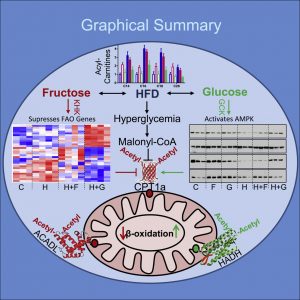High levels of fructose in the diet inhibit the liver’s ability to properly metabolize fat. This effect is observed when a high-fat diet is supplemented by fructose—but not glucose. The problem, according to scientists based at the Joslin Diabetes Center, is that fructose impairs the function of the liver’s mitochondria.
“Fructose makes the liver accumulate fat,” said C. Ronald Kahn, MD, chief academic officer at Joslin and a professor of medicine at Harvard Medical School. “It acts almost like adding more fat to the diet. This contrasts the effect of adding more glucose to the diet, which promotes the liver’s ability to burn fat, and therefore actually makes for a healthier metabolism.”
Kahn is also the senior author of an article that describes how the fructose effect unfolds at the molecular level. This study, “Dietary Sugars Alter Hepatic Fatty Acid Oxidation via Transcriptional and Post-translational Modifications of Mitochondrial Proteins,” appeared October 1 in Cell Metabolism. The article describes how the Joslin researchers used animal models to compare the metabolic consequences of six different diets: regular chow, chow with high fructose, chow with high glucose, a high-fat diet (HFD), an HFD with high fructose, and an HFD with high glucose.
“Fructose and glucose supplementation of an HFD exert divergent effects on hepatic mitochondrial function and fatty acid oxidation,” wrote the article’s authors. “This is mediated via three different nodes of regulation, including differential effects on malonyl-CoA levels, effects on mitochondrial size/protein abundance, and acetylation of mitochondrial proteins.”
Malonyl-CoA, an intermediate in the synthesis of long-chain fatty acids, is also a potent inhibitor of fatty acid oxidation. Specifically, it inhibits CPT1A (carnitine palmitoyltransferase 1A), the key enzyme in transporting components of fatty acids onto carnitine across the mitochondrial inner membrane.
CPT1 is responsible for the formation of acylcarnitine from ACADL (acyl-coenzyme A dehydrogenase, long chain), which is responsible for beta-oxidation of fatty acids within the mitochondria. ACADL dysfunction is associated with lowered fatty acid oxidation capacity, decreased heat generation, and overall insulin resistance.
“HFD- and HFD plus fructose-fed mice have decreased CTP1a activity, the rate-limiting enzyme of fatty acid oxidation, whereas knockdown of fructose metabolism increases CPT1a and its acylcarnitine products,” the article’s authors added. “Furthermore, fructose-supplemented HFD leads to increased acetylation of ACADL and CPT1a, which is associated with decreased fat metabolism.”
In addition to monitoring mitochondrial markers of fatty liver, the researchers investigated the mitochondria themselves. “When mitochondria are healthy, they have this nice ovoid shape and crosshatching,” said Kahn. “In the high-fat plus fructose group, these mitochondria are fragmented and they’re not able to burn fat as well as the healthy mitochondria. But looking at the high-fat diet plus glucose group, those mitochondria become more normal looking because they are burning fat normally.”

“The most important takeaway of this study is that high fructose in the diet is bad,” Kahn declared. “It’s not bad because it’s more calories, but because it has effects on liver metabolism to make it worse at burning fat. As a result, adding fructose to the diet makes the liver store more fat, and this is bad for the liver and bad for whole body metabolism.
“Surprisingly, when you switch the sugar in the diet from fructose to glucose, even though they’re both equally caloric, the glucose doesn’t have that effect. In fact, if anything, overall metabolism is somewhat better than if they just were on a plain high-fat diet.”
Kahn and colleagues believe that developing a drug that blocks fructose metabolism could prevent the negative actions of fructose and help prevent fatty liver disease and its adverse metabolic consequences, including impaired glucose tolerance and type 1 diabetes.



